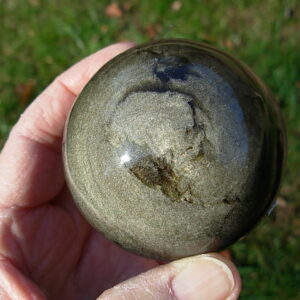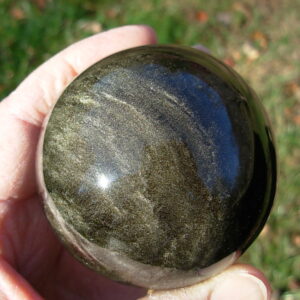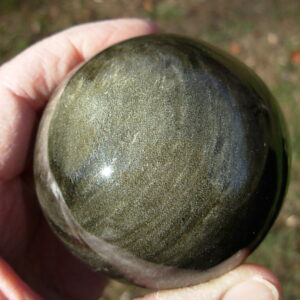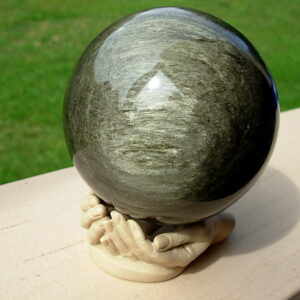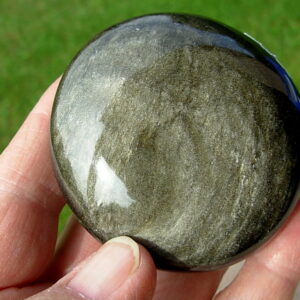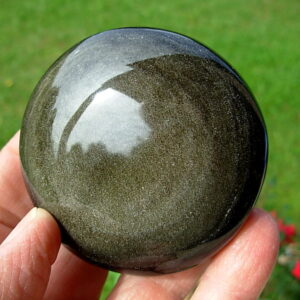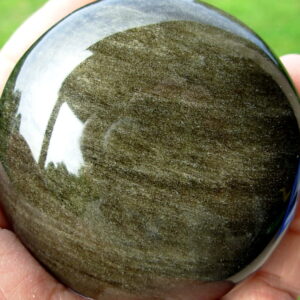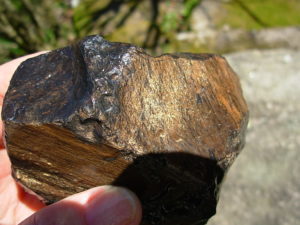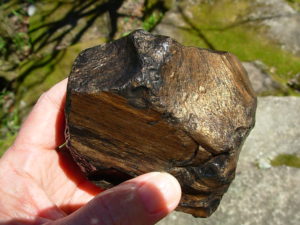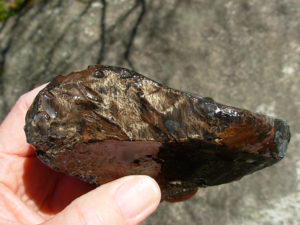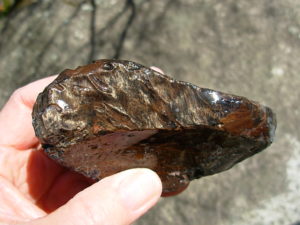Gold Sheen Obsidian
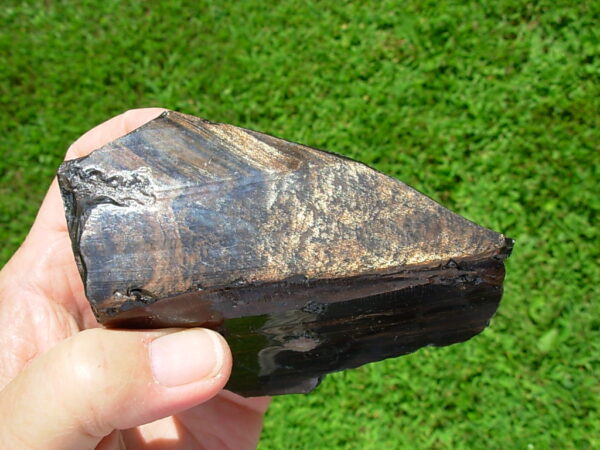
Gold Sheen Obsidian...The various colors of obsidian are a result of several factors. Clear varieties of obsidian contain very few opaque impurities or microscopic mineral crystals. Red or brown obsidian generally results from tiny crystals or inclusions of hematite or limonite (iron oxide). Abundant, microscopic crystals of minerals like magnetite, hornblende, pyroxene, plagioclase and biotite, combined with tiny fragments of rock, likely produce the jet-black varieties of obsidian. Microscopic crystals of various types of feldspars may yield the unique blue, green, purple or bronze colors associated with rainbow obsidian. The reflectance of rainbow obsidian is likely attributed to a preferred orientation of microscopic crystals of feldspar or mica oriented along flow layers.
A certain amount of water always is present in obsidian. Very small inclusions of water vapor in the form of bubbles often are trapped in the glass. Tiny gas bubbles that have been stretched nearly flat along the flow layers in obsidian generally cause the reflectance of gold sheen and silver sheen obsidian. Some of these bubbles are visible to the naked eye. The bubbles can be seen readily with a strong magnifying glass or a microscope. Obsidian is relatively unstable from a geologic perspective. It is rare to find obsidian older than about 20 million years, which is very young in comparison to most continental rocks that form the Earth's crust. Over a long period of time, obsidian gradually changes from glass to rock in a process known as "devitrification." In this process, the silica molecules within the glass slowly rearrange into organized crystal patterns. The "snowflakes" in snowflake obsidian are quartz crystals that have formed through devitrification of the original obsidian. The crystals that develop through devitrification cause obsidian to lose its conchoidal fracture and glassy texture.
information source courtesy of http://volcano.oregonstate.edu/obsidian
Obsidian is relatively soft with a typical hardness rating of 5 to 5.5. Obsidian, unlike crystals, has no regular structure and therefore fractures in smooth conchoidal (curved) shapes. Quality Gold Sheen Obsidian is in high demand for making jewelery. Photos above we took of specimens we procured in South Western Utah during our 2012 rock finding trip to Utah.
The Nevada, Utah and California area, referred to as the Great Basin, is an ideal location to find Obsidian. There are a myriad of colors, patterns and mixes of Obsidians, making them a very desirable collector item. Below are some pieces from our inventory and trips to Utah. (Photos of rough shown wet)
Nice Gold Sheen Obsidian is getting hard to find..... It is from the Black Rock Desert in western Utah where it was geologically deposited approximately 2.5 million years ago (the late Tertiary Period), during volcanic eruptions in the Black Spring area of the Black Rock Desert area in western Utah.
Jalisco Mexico has become a provider of some of the finest natural gold sheen, silver sheen and rainbow Obsidian found in the world. (CAUTION....Buyer Beware....There are man made fakes being shipped in from China and sold as gold sheen or silver sheen obsidian)
-
66mm Gold Sheen Obsidian Sphere 39
$36.00 Read more -
68mm Gold Sheen Obsidian Sphere 37
$37.00 Read more -
70 mm Gold Sheen Obsidian Sphere 38
$39.00 Read more -
70mm Gold Sheen Obsidian Sphere 36
$38.00 Read more -
87mm Gold Sheen Obsidian Sphere 40
$79.00 Read more -
Gold Sheen Obsidian Palm Stone T
$30.00 Read more -
Gold Sheen Obsidian Palm Stone U
$29.00 Read more -
Gold Sheen Obsidian Palm Stone V
$28.00 Read more
Item # 5OBGS04193531
Gold Sheen Obsidian Rough

Gold Sheen Obsidian Rough from Utah (photographed wet)
This specimen weighs 17oz or 1.06 pounds 483g ) and measures 3.6 x 2.8 x 2.3 inches (9.2 x 7.1 x 5.9 cm) This piece has good sheen! (sheen seen at correct viewing angle determines cutting or polishing angles)
Item # 6OBGS04194701
Gold Sheen Obsidian Rough

Gold Sheen Obsidian Rough from Utah (photographed dry in its natural state)
This specimen weighs 13.5oz or 0.85 pounds (383g ) and measures 4 x 2.6 x 1.9 inches (10.3 x 6.8 x 4.8 cm) This piece has good sheen! (sheen seen at correct viewing angle determines cutting or polishing angles)

